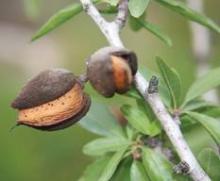A tree species belonging to the Rosaceae family and native to the Middle East and South Asia, Prunus dulcis (also called Prunus amygdalus), popularly known as almond, is cultivated widely in warm, arid locations and used primarily for its edible seeds (J. Agric. Food Chem. 2007;55:8498-507; J. Agric. Food Chem. 2006;54:312-8). Almonds and almond skins are rich in polyphenols and are an important source of these phytonutrients, particularly flavan-3-ols and flavonols (J. Proteome Res. 2010;9:5859-67). Almonds also are known to contain an abundance of fiber (Anaerobe 2014;26:1-6). Almond extracts are used in cosmetic formulations because of their high concentration of polyphenols, particularly flavonoids and phenolic acids (Int. J. Curr. Pharm. Res. 2011;3:57-9).
Key components
In 2006, Milbury et al. determined that the main flavonoids and phenolic acids in Prunus dulcis skins and kernels are isorhamnetin-3-O-rutinoside and isorhamnetin-3-O-glucoside (in combination), catechin, kaempferol-3-O-rutinoside, epicatechin, quercetin-3-O-galactoside, and isorhamnetin-3-O-galactoside (J. Agric. Food Chem. 2006;54:5027-33).
In a separate study that year, Wijeratne et al. identified quercetin, isorhamnetin, quercitrin, kaempferol 3-O-rutinoside, isorhamnetin 3-O-glucoside, and morin as the primary flavonoids in various whole-seed, brown, skin, and green-shell-cover almond extracts (J. Agric. Food Chem. 2006;54:312-8). Almond seed skin also has been shown to contain highly polymerized polyphenols that exhibit potent alpha-amylase inhibitory activity, thus slowing the absorption of carbohydrate (J. Agric. Food Chem. 2013;61:4570-6).
In 2010, Bartolomé et al. identified A- and B-type procyanidin, propelargonidin, and prodelphinidin polymers in almond skins. In human plasma and urine samples taken after consumption of almond skin polyphenols, the investigators detected O-methyl glucuronide sulfate and O-methyl sulfate derivatives of (epi)catechin; the glucuronide conjugates of naringenin and isorhamnetin; and sulfate conjugates of isorhamnetin, together with conjugates of hydroxyphenylvalerolactones. They also identified various microbial-derived metabolites, including hydroxyphenylpropionic, hydroxyphenylacetic, hydroxycinnamic, hydroxybenzoic, and hydroxyhippuric acids (Arch. Biochem. Biophys. 2010;501:124-33).
A functional food: Antioxidant constituents and activity
In a study of two human subjects conducted in 2009, Urpi-Sarda et al. profiled microbial-derived phenolic metabolites in plasma and urine samples before and after the consumption of almond skins. They detected glucuronide, O-methyl glucuronide sulfate, and O-methyl sulfate derivatives of epicatechin, the glucuronide conjugates of naringenin and glucuronide, and sulfate conjugates of isorhamnetin. The researchers also detected, in their glucuronide and sulfate forms, microbial-derived metabolites of flavanols, including 5-(dihydroxyphenyl)-gamma-valerolactone and 5-(hydroxymethoxyphenyl)-gamma-valerolactone (J. Agric. Food Chem. 2009;57:10134-42).
A 2010 study with 24 volunteers conducted by Llorach et al. investigated urinary metabolome changes during the 24-hour period following ingestion of a single dose of almond skin extract. The participants, who were following a polyphenol-free diet for 48 hours, were divided into two groups: the almond skin group or a placebo group. Thirty-four metabolites were linked to the consumption of the almond extract (J. Proteome Res. 2010;9:5859-67).
Monagas et al. previously led a comprehensive investigation of the phenolic composition of almond skins to elucidate its potential as a functional food. They identified 33 compounds, including flavanols, flavonols, dihydroflavonols, and flavanones, as well as nonflavonoid substances. The most abundant phenols were flavanols (38%-57%) and flavonol glycosides (14%-35%). Further, the researchers measured the oxygen radical absorbance capacity of almond skins at 0.398-0.500 mmol Trolox/g, a range that suggests its antioxidant potency (J. Agric. Food Chem. 2007;55:8498-507).
In 2008, Garrido et al. investigated the phenolic composition and antioxidant activity of almond skins (Prunus dulcis) obtained from three almond varieties and through various industrial processes, including blanching, blanching and drying, as well as roasting. Identified were 31 phenolic compounds, including flavan-3-ols, flavonol glycosides, hydroxybenzoic acids and aldehydes, flavonol aglycones, flavanone glycosides, flavanone aglycones, hydroxycinnamic acids, and dihydroflavonol aglycones. Phenolic content as well as antioxidant activity were significantly higher in the roasted samples (J. Food Sci. 2008;73:C106-15).
In 2014, Liu et al. conducted a study in healthy humans of the potential prebiotic effects of consuming almonds and almond skins. For 6 weeks, 48 adult volunteers ingested a daily dose of roasted almonds, almond skins, or a positive control (commercial fructo-oligosaccharides). The investigators collected fecal samples and analyzed them for microbiota composition. They observed significant increases in populations of Bifidobacterium spp. and Lactobacillus spp. in fecal samples after almond or almond skin supplementation; substantial inhibition of the growth of the pathogen Clostridium perfringens; and favorable changes in bacterial enzyme activities. They concluded that almonds and almond skins appear to exhibit potential prebiotic qualities (Anaerobe 2014;26:1-6).
Topical antiaging potential
In 2011, Sachdeva and Katyal assessed the antioxidant and antiwrinkle effects of almond skin extracts in UV-induced photoaging in mice. Twenty-five mice were used as an unirradiated control, receiving neither UV exposure nor almond skin treatment. A second group of 24 mice received only UV exposure of 5 minutes twice a day, and served as an irradiated control. Further groups of 24 mice received both UV radiation and treatment with prepared formulation. The treatment groups received various topical almond skin extract doses 2 hours prior to the same level of UV exposure. Significant decreases in malondialdehyde and increases in glutathione levels, respectively, suggested to the investigators that the almond skin extracts effectively scavenged free radicals while also enhancing moisturization. They concluded that almond skin extracts display potential as antiaging ingredients in topical cosmetic formulations (Int. J. Curr. Pharm. Res. 2011;3:57-9).



